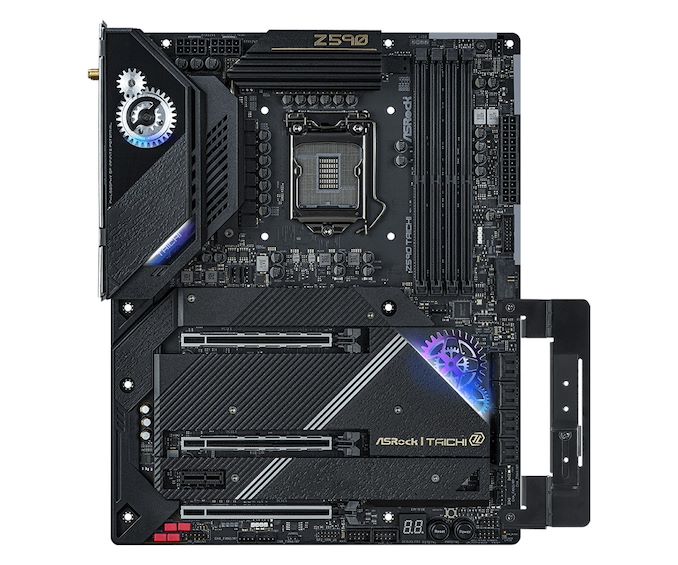The Intel Z590 Motherboard Overview: 50+ Motherboards Detailed
by Gavin Bonshor on January 19, 2021 10:15 AM ESTWe start with ASRock's models by opening up our overview of each Z590 motherboard in alphabetical order (by the vendor). ASRock uses the latest Intel Killer Wi-Fi 6E CNVi across its models. There is also an an ASRock Graphics Card Holder, designed to support bulky cards.
ASRock Z590 Taichi
Many years ago, ASRock entered into a sponsorship deal with a successful gamer to produce its gaming models. What they got was mostly a name to sell the hardware, and since then ASRock's most notable motherboard line is now the Taichi. Originally unveiled for Intel's Z270 chipset, it's a regular mainstay with its solid blend of cogwheel inspired aesthetics and premium features. The ASRock Z590 Taichi is ATX and looks to be the brand's flagship model at present.

ASRock Z590 Taichi with ASRock's new GPU holder
For 2021, the ASRock Z590 Taichi has opted for a more clean-cut all-black aesthetic, with RGB LED lighting elements within the rear panel, the chipset heatsink, and the underside of the board at the right-hand side. ASRock is also advertising an 8-layer PCB with a 14-phase power delivery with 90 A power stages. The Z590 Taichi includes three full-length slots, with the top slot operating at PCIe 4.0 x16, two of them running at x8/x8, and a single small PCIe 3.0 x1 slot. Other features include triple M.2 slots, with one operating at PCIe 4.0 x4 from the CPU and two with PCIe 3.0 x4 from the chipset. These final two have SATA support, as well as the eight traditional SATA ports. It also includes four memory slots with support for DDR4-5000 memory, with a maximum capacity of 128 GB.
The rear panel includes dual Thunderbolt/USB 4.0 Type-C ports, with two USB 3.2 G2 Type-A and four USB 3.2 G1 Type-A ports. It includes dual Ethernet, one driven by a Killer E3100G 2.5 G NIC and the other by an undisclosed Intel Gigabit controller. Wireless connectivity comes from an undisclosed Wi-Fi 6E interface, likely the Intel AX210, which includes support for BT 5.2. It uses a Realtek ALC1220 HD audio codec for onboard audio, with an assisting ESS Sabre ES9128 DAC for uprated audio capability. There is also a single HDMI video output.
At the time of writing, ASRock hasn't shared details on its Z590 pricing.











88 Comments
View All Comments
Oxford Guy - Tuesday, January 19, 2021 - link
You’ll never be able to block all the spyware with a firewall. Windows is just one component of it. Don’t forget things like stealth CPUs that are built into the CPU, like the little friend on Lando’s shoulder. Etc.lmcd - Tuesday, January 19, 2021 - link
What, the tinfoil hat isn't enough anymore? The "spyware" is just as present on any Windows era.If you want to disable built in telemetry, pay for pro and disable it in the registry. It's not hard if you're really that into privacy.
Spunjji - Wednesday, January 20, 2021 - link
@lmcd - but that would require *effort* - why waste that effort on customising a modern OS, when he could expend more effort cobbling together a barely-working platform on a 12-year-old one? 😂Makaveli - Wednesday, January 20, 2021 - link
lol all I saw in my head reading those post are "old man yells at clouds"Oxford Guy - Friday, January 22, 2021 - link
That’s due to the fact that the old man has just as much chance of getting the spyware out of Windows and CPUs (and the rest) as you lot have a chance of saying something relevant.Oxford Guy - Friday, January 22, 2021 - link
Call us when the shuttle lands, Pauline.Slash3 - Tuesday, January 19, 2021 - link
Z590 only provides six native SATA ports.ASRock's Z590 Taichi has eight ports, with two via an ASMedia ASM1061 controller.
Silver5urfer - Wednesday, January 20, 2021 - link
Got it thanks. I suppose that's how the EVGA Dark got it's 8 SATA ports too.weilin - Thursday, April 29, 2021 - link
Z590, if i remember correctly... has 30 HSIO lanes total:6 of which are dedicated to USB (and can be ganged in pairs for 20Gb/s ports)
4 more that is either USB 10Gb/s or 5Gb/s or PCIe.
2 of them which can be Ethernet or PCIe,
2 of them which can be SATA, Ethernet, or PCIe.
6 of them which can be SATA or PCIe.
10 dedicated PCIe
So everything all together means theoretically maximum of:
4 LAN ports
8 SATA ports
10 USB ports
24 PCIe ports
It's up to motherboard manufacturers to configure them as they see fit. It seems like the popular choice is to maximize USB, leave SATA at 6 and put the rest on PCIe ports (take 1 or 2 away for Ethernet, and 4 away for Thunderbolt if present).
weilin - Thursday, April 29, 2021 - link
If anyone's interested in see the doc:https://ark.intel.com/content/www/us/en/ark/produc...
On to left its under "Technical Documentation" -> "Intel® 500 Series Chipset Family Platform Controller Hub Datasheet, Volume 1 of 2" -> bottom of page 18